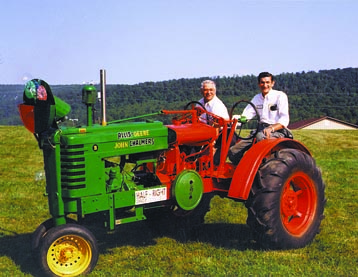"It gets a lot of looks wherever we go," says Steve Grieb, Centre Hall, Penn., about the "half right" tractor that he and friend Paul Dotterer built. The front half of the tractor is a 1940's Deere B and the rear half is a 1940s Allis-Chalmers WC. The tractor is owned jointly by Grieb -- a Deere dealer -- and Dotterer -- formerly an Allis-Chalmers dealer. It has two seats -- a green one and an orange one; two steering wheels -- one green and one orange; and a homemade bubble machine on front. The steering wheels are tied together with sprockets and chains, allowing the tractor to be driven by either one or two drivers. The centrally-located hand clutch and throttle are accessible from either seat, as are a pair of hand brakes. The original Deere 2-cyl. engine was replaced with one from the LUC power unit off a 1940's Deere combine. The engine is connected to the Allis transmission. "We take it to a lot of steam engine shows and often drive it in parades. People take a lot of photographs of it," says Grieb. "A lot of people who are familiar with equipment really appreciate it, but the average person thinks that we bought it. Paul and I have been friends for years and built it just for fun. Since I'm a Deere dealer he says that I'm not allowed to sit in the orange seat. We did the work during evenings and weekends. We fabricated a clutch and pressure plate for the fly-wheel and mounted a hand clutch. The original Deere B had a hand clutch, too. We made a new exhaust for the tractor in order to quiet it down. The LUC Deere combine engine still makes a 'putt putt' sound just like the engine on the original tractor. "One time a married couple drove the tractor during an antique show. Both had lost their first mates. They thought it would be fun to drive because the woman's former husband was an Allis dealer but her new husband was a Deere dealer. "Kids get a big charge out of the bubble making machine on front which uses two 12-volt electric motors -- one to spin paddle wheels that pick up the bubble solution, and the other to operate a fan. The first time we started up the bubble making machine the motor that operates the fan ran backward, causing the fan to blow in the wrong direction. The problem was that the motor wasn't grounded properly. The only way to reverse the motor was to reverse the wires, but we couldn't do that because of the grounding problem. We solved the problem by mounting both motors on a 2 by 8 wooden frame."
1-800-834-9665
"Half Right" Tractor Is Big Hit At Parades
FARM SHOW Magazine » "Half Right" Tractor Is Big Hit At Parades
"Half Right" Tractor Is Big Hit At Parades
